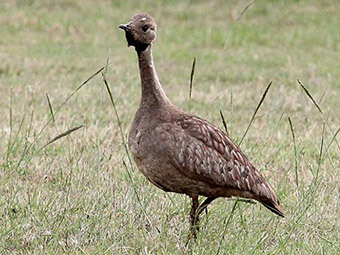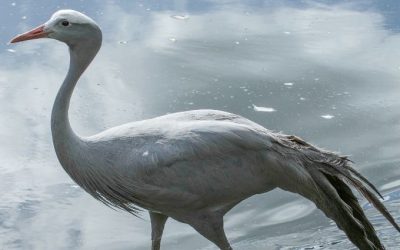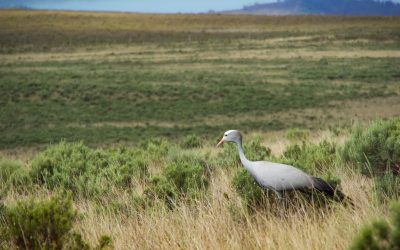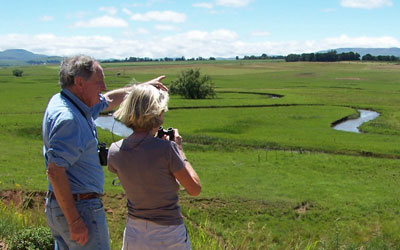Welcome to the Overberg Crane Group
The Overberg Crane Group (OCG) works to protect the Blue Crane, South Africa’s national bird, and other threatened birds that live in the Overberg – an important birding region in South Africa. We’re a community organisation and therefore your involvement is vital.
THREATS
The natural habitat of Blue Cranes and other threatened birds like Cape Vultures, Secretary Birds, Black Harriers, Denham’s Bustards, Korhaans and Eagles is dwindling… even in the Overberg. This creates huge risks for these birds. Aside from habitat loss, a range of other man-made pressures threaten the very existence of these birds in the not-so-distant future.
WHAT WE DO
Working with partners, the Overberg Crane Group protects our threatened birds in three ways. We provide extension support to land users to deal with human-wildlife conflict. We raise awareness about our bird species in the Overberg and how to protect them. And we collect data on our bird populations to help us better understand the population trends and the threats to our birds.
HOW WE STARTED
The Overberg Crane Group launched as a Non-Profit Organisation (NPO 042-919; PBO 930 009 771) in 1991 – a collaboration between CapeNature and the Overberg community – to protect our Blue Cranes at a time when Blue Crane numbers were rapidly falling. In 2014, we changed our constitution to protect other threatened birds alongside Blue Cranes in the Overberg.
WHAT WE PROTECT
Blue Cranes and other threatened birds in the Overberg
Blue Cranes still face many threats – mainly power line collisions, poisonings and illegal capture. So the Overberg Crane Group still prioritises Blue Crane conservation. Blue Cranes are listed as Vulnerable on the International Union for Conservation of Nature’s Red List of Threatened Species. Only around 45,000 Blue Cranes remain in the world. With around half of the remaining Blue Crane population found in the Overberg, in the Western Cape, we have to protect our Blue Cranes here.
But the Overberg Crane Group realised so many other birds in the Overberg are facing risks, like the endangered Cape Vulture or the near-threatened Denham’s Bustard. So our support now also reaches these and other birds.












Get involved in conserving the birds in the Overberg
HOW YOU CAN HELP
Report dead or injured cranes. Let us know if you see any Blue Cranes with rings on their legs. Jot down where you’ve seen Blue Cranes and other threatened birds, to help us build a picture of our bird populations. Or get involved by donating.
%
From the original population of Blue Cranes, only 3% remains today, amounting to just 45 000 birds.
DEAD OR INJURED BIRDS
Blue Cranes and other birds are often found dead or injured in the Overberg. Please report dead or injured birds to our OCG Extension Officer, Christie Craig by email to support@bluecrane.org.za or phone 066 289 5988.
REPORT RINGED BIRDS
Hundreds of Blue Cranes have had rings placed on their legs over the years. We use these rings to identify Blue Cranes. With this information, we can learn more about them. If you see a Blue Crane with rings on its legs, please let us know.
SUPPORT
The Overberg Crane Group is the only organisation dedicated to protecting our Overberg’s birds, like Blue Cranes and Cape Vultures. We need your help to protect our threatened bird species from possible future extinction.
BIRDLASSER APP
There’s a convenient way for bird lovers to note the birds they see – using the BirdLasser app. You can download the BirdLasser app to your cellphone. It’s also a great tool for bird lovers to keep accurate records of their sightings




OUR LATEST NEWS
Wenke vir boere: Word ’n bondgenoot vir ons bloukraanvoëls
Soos die bloukraanvoël se natuurlike habitat krimp, word die bydrae van boere al belangriker in die stryd om die spesie vir die toekoms te bewaar. Deur sensitiewe bestuur, kan boere en bloukraanvoëls nie net vreedsaam
Concern for Blue Cranes as numbers fall
With Blue Crane numbers on the decline, especially in the Overberg, urgent conservation action is needed to protect South Africa’s national bird. According to the latest research looking at the Blue Crane population,
30 years of CAR counts: An OCG origin story
Today CAR counts still take place across the country. Nationally there are 350 fixed routes, covering more than 19 000 km, that citizen scientists drive twice a year. The goal is to look for terrestrial birds



